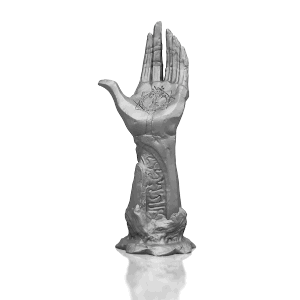I am learning as much or more designing Invisible Sun as I have during any other design. It’s as though the game itself occasionally has to rise up and smack me alongside my head to remind me, “I’m not like other games.”
Case in point. I had thought that the Cypher System’s design of keying character creation to a description sentence about the character was so good that I should use the same general idea here. But as I worked, and thought about the unique elements of the game, I realized that a character creation system that creates a sentence is really great for a book, but Invisible Sun isn’t a book. It’s a big Black Cube full of stuff (including, of course, books). This design needs to embrace the Black Cube. (Which really should be the name of a spell.)
So while the idea that, when you’re done you have a descriptive sentence still exists in Invisible Sun, it’s not what drives and guides character creation. The driver is something both visual and tactile, as befits a game that is a box full of cool stuff.
You’ve seen it back during the Kickstarter. It’s called the Testament of Suns. It’s a resin sculpture of a stylized, enruned six-fingered hand that goes in the box, and during gameplay it holds the Sooth deck card played on the Invisible Sun symbol on the Path of Suns board. That’s significant in itself—the card played there remains in effect for a long time and can shape the entire direction of a story. But there’s more. The Invisible Sun, remember, is the source of magic. Its guardian is Visla, and that’s why all Player Characters are called vislae. The Testament of Suns, while it has a relationship to the whole path, is also keyed specifically to the Invisible Sun. It is, in both a metaphorical and literal sense, the hand of magic, or the hand of Visla.

Thus, it is an item that all vislae carry with them. But it’s more than a symbol of Visla, it’s a symbol that represents the vislae carrying it. Because the six fingers each represent an aspect of the character. So one PC’s Testament is different from another’s. Your Testament is a symbol of Visla, but also of you. Without it, your spells and abilities don’t work quite as well. It’s a bit of yourself and your own power invested into an object. Over time, as your character advances, your Testament can gain special abilities, because as your power grows, so does it.
It becomes entirely natural, then, that character creation is keyed to the Testament as a visual guide. There are six basic components of character creation, and you count them off on the fingers (and thumb) of the Testament of Suns as you move through the process. It’s used in illustrations in those chapters to represent it, but the players likely have the physical version in front of them as well. Visual and tactile.
As an aside, the aspects of a character are Order, Heart, Forte, Soul, Foundation, and Character Arc. The first four define the character and what they can do. The latter two represent the past and the future of the character. In the language of the vislae, the six aspects are Tor, Da, Tu, Ka, La, and Ver. Because Apostates can be belligerent and reject all the things that other vislae hold dear, they don’t carry a Testament. Instead, they carry a metal or crystal device they call the vertula kada (ver-tu-la ka-da, it’s the aspects of the character other than tor, because they eschew the orders of magic). Apostates make this design really fun to work on because almost everything that I create, like the Testament of Suns, they reject. They break all the rules.
But to return to the original point, the game keeps reminding me that while it is extremely word-focused, it offers opportunities to look beyond just words and utilize other things. It matures and changes as it goes along as it reminds me of that fact every step of the way.
I could do without the smacks upside the head, but what are you going to do?